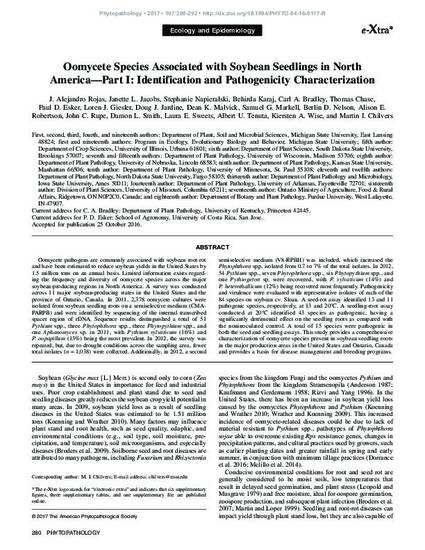
Oomycete pathogens are commonly associated with soybean root rot and have been estimated to reduce soybean yields in the United States by 1.5 million tons on an annual basis. Limited information exists regarding the frequency and diversity of oomycete species across the major soybean-producing regions in North America. A survey was conducted across 11 major soybean-producing states in the United States and the province of Ontario, Canada. In 2011, 2,378 oomycete cultures were isolated from soybean seedling roots on a semiselective medium (CMA-PARPB) and were identified by sequencing of the internal transcribed spacer region of rDNA. Sequence results distinguished a total of 51 Pythium spp., three Phytophthora spp., three Phytopythium spp., and one Aphanomycessp. in 2011, with Pythium sylvaticum (16%) and P. oopapillum (13%) being the most prevalent. In 2012, the survey was repeated, but, due to drought conditions across the sampling area, fewer total isolates (n = 1,038) were collected. Additionally, in 2012, a second semiselective medium (V8-RPBH) was included, which increased the Phytophthoraspp. isolated from 0.7 to 7% of the total isolates. In 2012, 54 Pythium spp., seven Phytophthora spp., six Phytopythium spp., and one Pythiogeton sp. were recovered, with P. sylvaticum (14%) and P. heterothallicum (12%) being recovered most frequently. Pathogenicity and virulence were evaluated with representative isolates of each of the 84 species on soybean cv. Sloan. A seed-rot assay identified 13 and 11 pathogenic species, respectively, at 13 and 20°C. A seedling-root assay conducted at 20°C identified 43 species as pathogenic, having a significantly detrimental effect on the seedling roots as compared with the noninoculated control. A total of 15 species were pathogenic in both the seed and seedling assays. This study provides a comprehensive characterization of oomycete species present in soybean seedling roots in the major production areas in the United States and Ontario, Canada and provides a basis for disease management and breeding programs.
Available at: http://works.bepress.com/alison-robertson/250/

This article is published as Alejandro Rojas, J., Janette L. Jacobs, Stephanie Napieralski, Behirda Karaj, Carl A. Bradley, Thomas Chase, Paul D. Esker et al. "Oomycete species associated with soybean seedlings in North America—Part I: Identification and pathogenicity characterization." Phytopathology 107, no. 3 (2017): 280-292. doi: 10.1094/PHYTO-04-16-0177-R. Posted with permission.